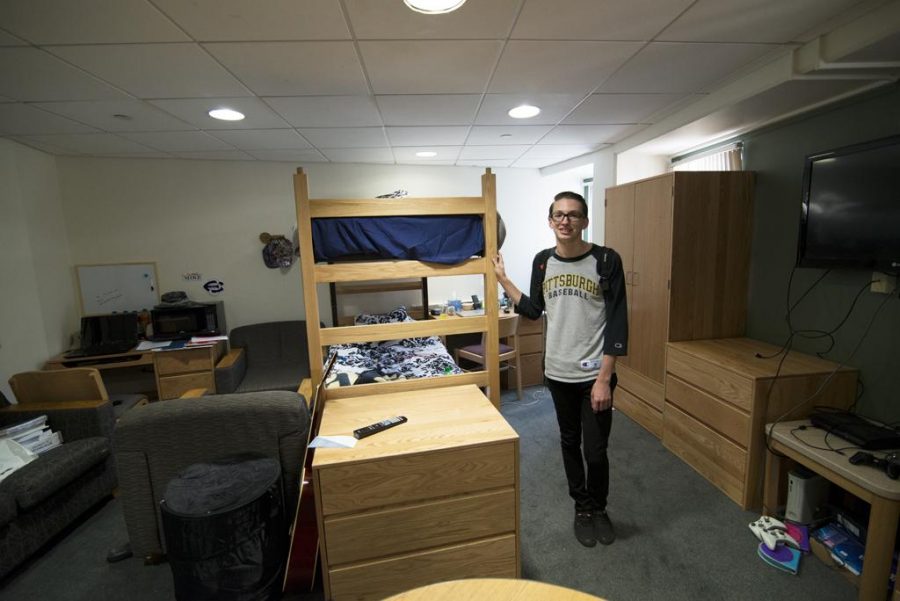Pitt’s chief enrollment officer Marc Harding said trying to exactly predict the freshman class size is “like trying to land a jumbo jet on a dime.”
Regardless of the number of applications, the University aims to bring around 3,900 new fresh faces to campus every year, and while Pitt doesn’t hit the number on the dime, it gets pretty darn close.
“The art and science of enrollment management is based on a lot of data, and we stay within 100 to 200 students of our 3,900 student class size goal, which is a great feat,” Harding said.
The art and science of making sure all those students have a place to call home is an entirely different call to ground control. Giving students housing often means getting creative.
This year, the freshmen class is 4,074 students strong, beating Pitt’s 3,900 target by nearly 200. To compare to the freshmen classes of previous years, Pitt added 3,897 students in 2012 and 3,992 in 2013. But with more students living on campus, Pitt has had to expand housing for 90 freshmen this year. While other freshmen will live in dorm rooms, Pitt will house those 90 students in 24 converted lounges in Litchfield Towers, Lothrop Hall and Fraternity Houses 8 and 9.
The expanded housing areas will bear much of the same amenities — twin XL bed, desk and dresser — as other freshman dorms, plus the possibility of a TV or table left over from when the rooms served as lounges.
Both first-year men and women will live in the converted lounges, yet the two fraternity houses will host only first-year students who identify as male.
Pricing for the expanded housing will be similar to traditional freshman dorms. For a triple, Pitt charges between $2,750 and $3,350 per semester depending on the building. The cost of a converted lounge triple will be $2,750 per semester, according to Pitt’s housing website.
Houses 8 and 9 will cost $3,350 per semester, which puts them within the typical price range for doubles: $3,150 to $3,675 per semester. Prices for a single in one of the fraternity houses will be $3,650 per semester, whereas Pitt charges $3,250 to $3,450 for a single in Lothrop or other dorms per semester.
In the future, predicting class size maybe more like trying to land a rocket ship on a thumbtack, as Harding said Pitt is getting more and more applicants who are stronger and smarter than ever. If Pitt wants to keep admitting 3,900 students a year, Harding said the University will have to get more selective.
Over the last year, Pitt received 30,631 applications, its highest amount ever. Of those, Pitt admitted 16,499 students, giving it a 53.9 percent acceptance rate. Comparatively, in 2014, Penn State University’s acceptance rate was 55.5 percent, and Carnegie Mellon University’s was 23.6 percent.
For the past 15 years, Pitt’s acceptence rate has hovered around 55 percent. But in 2000, for example, Pitt only brought in 2,940 new students. That year, the average math and reading SAT score of Pitt applicants was 1169. By last year, the average score rose to 1294. Because Pitt has received more applications and still only accepts a little more than half, competition for those spots has increased, Harding said.
“We are getting more selective, but it’s because there’s more competition for those spots,” Harding said. “Pitt’s been on that trajectory for a number of years.”
Freshman Morgan Murphy made the cut in the applications process and is one of the students living in a converted lounge in Tower A.
Murphy was confused when she saw she had three other roommates. She had requested a double and thought she and her roommates would have to squeeze bunk beds into a regular two-person room.
“But I also knew that didn’t really make any sense, so I was excited because I thought it would be fun to have more roommates,” Murphy, a nursing major, said.
Lucas Zenobi, who lives with two other freshmen in a Tower C lounge, said one of the downsides to living in the converted space is that his alone time is limited to when his roommates are not home.
“It’s cramped, but not cramped at the same time,” Zenobi, a freshman math major, said.
Because Pitt considers the Fraternity Houses and converted lounges as just additional dorm rooms when it needs more space, Panther Central didn’t specially notify the 90 students living in them.
“Students should feel no different when moving into these rooms,” Julie Bannister, Panther Central’s manager, said in an email.
Residence Life Director Steven Anderson said no one has complained about living in a lounge and many students were happy about the change because of the extra space.
“It’s not about what hall you’re in,” Anderson said, “it’s about who you’re surrounded by.”


